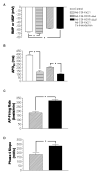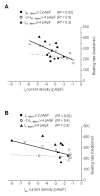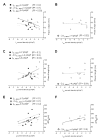Synergistic effects of inward rectifier (I) and pacemaker (I) currents on the induction of bioengineered cardiac automaticity
- PMID: 19460073
- PMCID: PMC2739246
- DOI: 10.1111/j.1540-8167.2009.01475.x
Synergistic effects of inward rectifier (I) and pacemaker (I) currents on the induction of bioengineered cardiac automaticity
Abstract
Introduction: Normal heart rhythms originate in the sinoatrial node. HCN-encoded funny current (I(f)) and the Kir2-encoded inward rectifier (I(K1)) counteract each other by respectively oscillating and stabilizing the negative resting membrane potential, and controlling action potential firing. Therefore, I(K1) suppression and I(f) overexpression have been independently exploited to convert cardiomyocytes (CMs) into AP-firing bioartificial pacemakers. Although the 2 strategies have been largely assumed synergistic, their complementarity has not been investigated.
Methods and results: We explored the interrelationships of automaticity, I(f) and I(K1) by transducing single left ventricular (LV) CMs isolated from guinea pig hearts with the recombinant adenoviruses Ad-CMV-GFP-IRES-HCN1-AAA and/or Ad-CGI-Kir2.1 to mediate their current densities via a whole-cell patch clamp technique at 37 degrees C. Results showed that Ad-CGI-HCN1-AAA but not Ad-CGI-Kir2.1 transduction induced automaticity (181.1 +/- 13.1 bpm). Interestingly, Ad-CGI-HCN1-AAA/Ad-CGI-Kir2.1 cotransduction significantly promoted the induced firing frequency (320.0 +/- 15.8 bpm; P < 0.05). Correlation analysis revealed that the firing frequency, phase-4 slope and APD(90) of AP-firing LV CMs were correlated with I(f) (R(2) > 0.7) only when -2 >I(K1) >-4 pA/pF but not with I(K1) over the entire I(f) ranges examined (0.02 < R(2) < 0.4). Unlike I(f), I(K1) displayed correlation with neither the phase-4 slope (R(2)= 0.02) nor phase-4 length (R(2)= 0.04) when -2 > I(f) > -4 pA/pF. As anticipated, however, APD(90) was correlated with I(K1) (R(2)= 0.4).
Conclusion: We conclude that an optimal level of I(K1) maintains a voltage range for I(f) to operate most effectively during a dynamic cardiac cycle.
Figures






Similar articles
-
Mechanistic role of I(f) revealed by induction of ventricular automaticity by somatic gene transfer of gating-engineered pacemaker (HCN) channels.Circulation. 2007 Apr 10;115(14):1839-50. doi: 10.1161/CIRCULATIONAHA.106.659391. Epub 2007 Mar 26. Circulation. 2007. PMID: 17389267 Free PMC article.
-
Overexpression of HCN-encoded pacemaker current silences bioartificial pacemakers.Heart Rhythm. 2008 Sep;5(9):1310-7. doi: 10.1016/j.hrthm.2008.05.010. Epub 2008 May 15. Heart Rhythm. 2008. PMID: 18693074
-
Automaticity and conduction properties of bio-artificial pacemakers assessed in an in vitro monolayer model of neonatal rat ventricular myocytes.Europace. 2010 Aug;12(8):1178-87. doi: 10.1093/europace/euq120. Epub 2010 May 14. Europace. 2010. PMID: 20472688 Free PMC article.
-
The role of the funny current in pacemaker activity.Circ Res. 2010 Feb 19;106(3):434-46. doi: 10.1161/CIRCRESAHA.109.208041. Circ Res. 2010. PMID: 20167941 Review.
-
Molecular regulation and pharmacology of pacemaker channels.Curr Pharm Des. 2007;13(23):2338-49. doi: 10.2174/138161207781368729. Curr Pharm Des. 2007. PMID: 17692005 Review.
Cited by
-
Electrical stimulation promotes maturation of cardiomyocytes derived from human embryonic stem cells.J Cardiovasc Transl Res. 2013 Dec;6(6):989-99. doi: 10.1007/s12265-013-9510-z. Epub 2013 Oct 1. J Cardiovasc Transl Res. 2013. PMID: 24081385
-
Mitochondria and metabolic transitions in cardiomyocytes: lessons from development for stem cell-derived cardiomyocytes.Stem Cell Res Ther. 2021 Mar 12;12(1):177. doi: 10.1186/s13287-021-02252-6. Stem Cell Res Ther. 2021. PMID: 33712058 Free PMC article. Review.
-
Probing the bradycardic drug binding receptor of HCN-encoded pacemaker channels.Pflugers Arch. 2009 Nov;459(1):25-38. doi: 10.1007/s00424-009-0719-2. Pflugers Arch. 2009. PMID: 19756722 Free PMC article.
-
Kir2 inward rectification-controlled precise and dynamic balances between Kir2 and HCN currents initiate pacemaking activity.FASEB J. 2018 Jun;32(6):3047-3057. doi: 10.1096/fj.201701260R. Epub 2018 Jan 12. FASEB J. 2018. PMID: 29401592 Free PMC article.
-
Triiodothyronine and dexamethasone alter potassium channel expression and promote electrophysiological maturation of human-induced pluripotent stem cell-derived cardiomyocytes.J Mol Cell Cardiol. 2021 Dec;161:130-138. doi: 10.1016/j.yjmcc.2021.08.005. Epub 2021 Aug 13. J Mol Cell Cardiol. 2021. PMID: 34400182 Free PMC article.
References
-
- DiFrancesco D. Pacemaker mechanisms in cardiac tissue. Annu Rev Physiol. 1993;55:455–72. - PubMed
-
- Irisawa H, Brown HF, Giles W. Cardiac pacemaking in the sinoatrial node. Physiol Rev. 1993;73:197–227. - PubMed
-
- Siu CW, Lieu DK, Li RA. HCN-encoded pacemaker channels: from physiology and biophysics to bioengineering. J Membr Biol. 2006;214(3):115–22. - PubMed
-
- Tse HF, Xue T, Lau CP, Siu CW, Wang K, Zhang QY, Tomaselli GF, Akar FG, Li RA. Bioartificial sinus node constructed via in vivo gene transfer of an engineered pacemaker HCN Channel reduces the dependence on electronic pacemaker in a sick-sinus syndrome model. Circulation. 2006 Sep 5;114(10):1000–11. - PubMed
Publication types
MeSH terms
Substances
Grants and funding
LinkOut - more resources
Full Text Sources
Other Literature Sources
Medical
Research Materials

